|
80x5 -
240x3 -
240x4 -
320x1 -
320x2 -
320x3 -
640x1 -
640x2
Set display option above.
Click on
images to enlarge. |
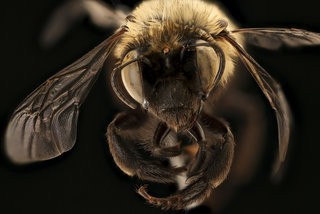
© Copyright source/photographer
· 7
Anthophora ursina, f, face, Dauphin County, PA |
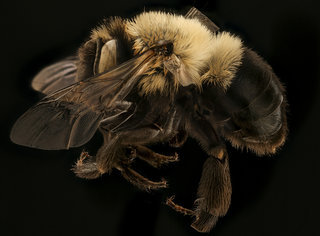
© Copyright source/photographer
· 7
Anthophora ursina, f, left, Dauphin County, PA |
|
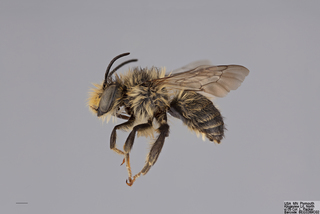
© Copyright Laurence Packer 2014
· 7
Anthophora ursina MALE mm .x f |
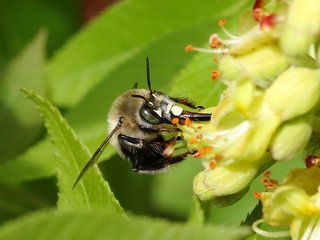
Michael Veit · 6
Anthophora ursina, m on Aesculus -- |
|
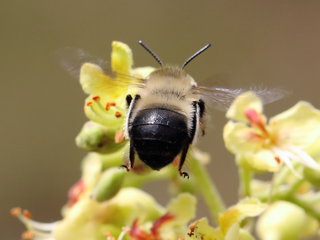
Michael Veit · 6
Anthophora ursina, m on Aesculus -- |
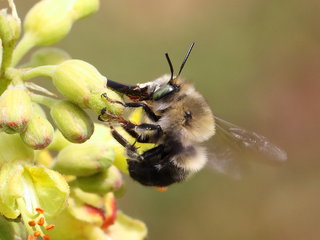
Michael Veit · 6
Anthophora ursina, m on Aesculus -- |
|
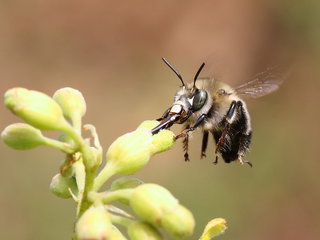
Michael Veit · 6
Anthophora ursina, m on Aesculus -- |
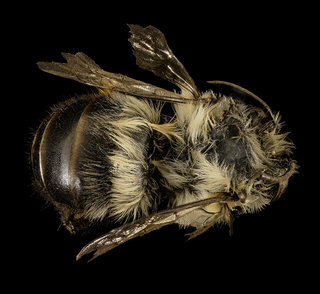
© Copyright source/photographer
· 5
Anthophora ursina, f, back, Hard Co, VA |
|
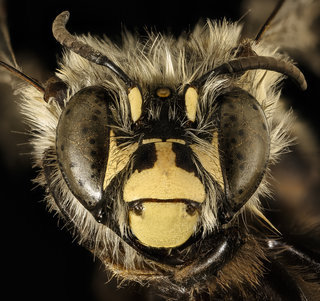
© Copyright source/photographer
· 5
Anthophora ursina, m, face, Hard Co, VA |
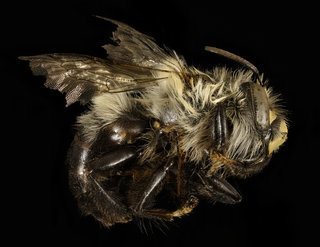
© Copyright source/photographer
· 5
Anthophora ursina, m, side, Hard Co, VA |
|
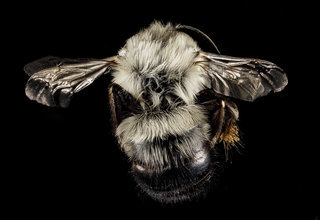
© Copyright source/photographer
· 5
Anthophora ursina, M, Back, Georgia, Fannin County |
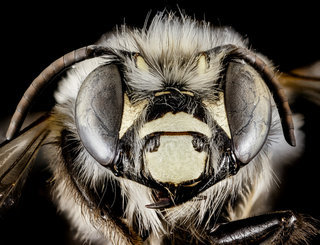
© Copyright source/photographer
· 5
Anthophora ursina, M, Face, Georgia, Fannin County |
|
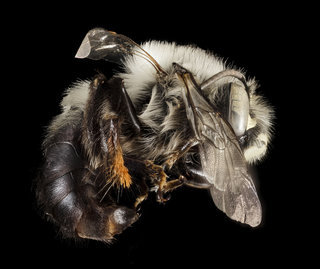
© Copyright source/photographer
· 5
Anthophora ursina, M, Side, Georgia, Fannin County |
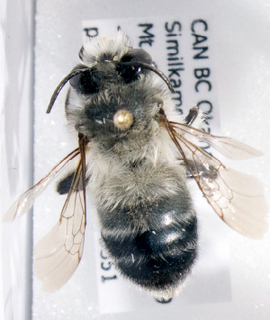
Barcode of Life Data Systems · 1
Anthophora ursina, Barcode of Life Data Systems |
|
Overview |
Reprinted with permission from: Mitchell, T.B. 1962 Bees of the Eastern United States. North Carolina Agricultural Experiment Station Technical Bulletin No. 152.
FEMALE�Length 15-16 mm., breadth of abdomen 6.5 mm.; black, antennal flagella somewhat more piceous beneath, legs black, spurs and tegulae piceous; wings uniformly, lightly infuscated, veins brownish to piceous; cheeks about equal to eyes in width; elypeus strongly protuberant, its median length about equal to half the distance between eyes below; mandibles with a low, subapical, inner tooth; median length of labrum about equal to basal width; eyes subparallel; basal segment of flagellum equal in length to segments 2-5 combined; face around and above antennae very finely and densely punctate, a limited shining area adjacent to lateral ocelli impunctate; clypeus quite coarsely and rather closely punctate, punctures becoming minute, irregular and vague apically, labrum rather coarsely reticulate; scutum dull and very densely tessellate, punctures fine, shallow, rather sparse in central area posteriorly, becoming much finer and closer laterally, fine and crowded on scutellum; pleura dull, punctures very fine and close; propodeum dull, rather smooth, punctures shallow, irregularly scattered, rather coarse on each side, lateral surfaces more shining, punctures rather shallow but distinct; punctures of abdominal terga very fine and quite close, becoming more widely separated on tergum 3, and to a lesser degree on 4; pygidium narrow at base, elongate, apex rather broadly rounded; pubescence of head entirely black, that on scutum, scutellum, propodeum, and pleura largely pale ochraceous above, long and copious, with a few scattered, dark hairs on scutum, black in large part on legs, pleura below and lateral faces of propodeum; hind tibial scopa of elongate, slender, relatively simple, black hairs; basal abdominal tergum with copious, elongate, pale ochraceous pubescence, this short and dark laterally, that on the remaining terga short but rather dense, erect and blackish or fuscous throughout.
MALE�Length 14.5-16 mm., breadth of abdomen 5.5-6.5 mm.; black, labrum largely yellow, clypeus yellow apically, with a narrow median yellow line reaching upper margin; lateral yellow maculae very narrowly produced along eye margin about to level of antennae; supraclypeal area very narrowly yellow along margin of clypeus; antennal scape yellow anteriorly; legs largely black, hind tarsi somewhat reddened, spurs fuscous to blackish; tegulae brownish-piceous; wings uniformly, very lightly infuscated, veins piceous to black; cheeks slightly narrower than eyes; clypeus strongly protuberant, its median length equal to about half the distance between eyes below; eyes subparallel; length and breadth of lab- rum about equal; mandibles with a distinct, inner, subapical tooth; basal segment of flagellum about equal to segments 2-4 combined; hind basitarsi slender and parallel-sided; median and upper areas of face very finely and densely punctate, becoming sparsely and minutely so below on each side of clypeus, the clypeal punctures fine and well separated medially, becoming somewhat closer laterally, apical punctures quite close; labrum shining, punctures very minute, irregularly scattered and sparse; cheeks dull, punctures very fine, close and obscure; vertex smooth and polished adjacent to each lateral ocellus, this area impunctate; scutum dull and densely tessellate, median posterior area nearly impunctate, the anterior and lateral areas very finely and densely punctate; scutellum finely and densely punctate except narrowly along anterior margin; pleura dull, very finely and densely punctate throughout; posterior face of propodeum rather dull, punctures fine and close, dorsal triangle somewhat smoother, with sparse, scattered, shallow punctures, lateral faces dull, very finely and closely punctate; basal abdominal tergum with fine, quite close and deep punctures, those on the following terga minute and more widely separated, becoming somewhat coarser, deeper and closer laterally, well separated but hardly sparse medially, fine and crowded on tergum 7; pubescence largely whitish on head, with scattered, erect, fuscous or blackish hairs across vertex and along lateral margins of face; scutum with generally pale pubescence but with numerous, scattered, intermixed dark hairs, that on scutellum, propodeum and pleura entirely whitish; pubescence of legs blackish in large part, but anterior trochanters and femora fringed posteriorly with long pale hairs; basal abdominal tergum with copious, elongate, pale ochraceous pubescence, following terga with short but erect, quite copious, black pubescence; tergum 7 narrowly produced medially, this process shallowly emarginate; sterna 7 and 8 and genital armature as shown (figs. 91 and 92).
DISTRIBUTION � New York and the New England states, south to Georgia, March to June.
FLOWER RECORDS � Azalea, Pedicularia, Pentstemon, Vaccinium and Vicia. Robertson (1929) records ursina on the following: Aesculus, Asclepias, Astragalus, Cercis, Collinsia, Delphinium, Dicentra, Dodecatheon, Geranium, Lithospermum, Lonicera, Mertensia, Monarda, Phlox, Physalis, Polygonatum, Polymonium, Ribes, Scutellaria, Trifolium and Viola.
The subspecific designation of ursina results from recognition of two additional subspecies found in the West.
|
|
|
Identification | |
Extracted from: Charles, R. (1895). Notes on bees, with Descriptions of New Species. Transactions of the American Entomological Society Vol. 22, No. 2. pp. 115-128.
This species is common in Illinois. The female bears a very
strong resemblance to Habropoda floridana Sm., but is distinguished
by the venation. It is distinguished from A. abrupta Say by its
larger size, the first segment of abdomen having more ochraceous
pubescence, and the ochraceous color of thorax not being continued
down the sides beyond the middle. The type of the male is faded,
fresh specimens having the pubescence of thorax more ochraceous.
|
|
|
Names | |
|
|
| Supported by | |
Updated: 2024-04-25 04:56:46 gmt
|